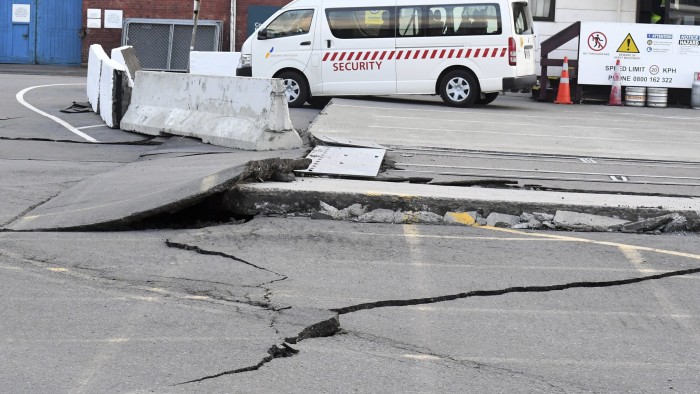New Zealand rocked by aftershocks after 7.8-magnitude earthquake

Roula Khalaf, Editor of the FT, selects her favourite stories in this weekly newsletter.
A powerful 7.8-magnitude earthquake struck New Zealand early on Monday causing widespread damage and prompting authorities to issue a tsunami warning to coastal communities.
John Key, New Zealand’s prime minister, said at least two people had died following the earthquake.
“We don’t have any indications at the moment to believe it will rise, but we can’t rule that out,” said Mr Key in Wellington, adding that details of the casualties were still being confirmed.
A series of powerful aftershocks followed later in the day, including a 6.3-magnitude quake which struck north of the town of Cheviot in Canterbury. Emergency services did not report any further casualties.
Tens of thousands of people fled their homes to take shelter on higher ground following the tsunami warning, with New Zealand authorities reporting that the first tsunami waves were generated within two hours of the earthquake. This warning was later downgraded for most areas. The Ministry for Civil Defence retained a marine and beach threat from large waves from Napier to north Dunedin, Cook Straight coastal areas and The Chatham Islands.
After reviewing the damage by helicopter, Mr Key told Radio New Zealand it would likely cost a “couple of billion dollars” to repair the damage caused by the earthquake. He has now cancelled a planned trip to Argentina this week.

The New Zealand dollar fell to its lowest level against the US dollar in about a month following the quake. The kiwi fell to 70.88 US cents at 8am in Wellington, from 71.26 cents in late New York trading on Friday.
“The whole house rolled like a serpent and some things smashed, the power went out,” a woman, who gave her name as Elizabeth, told Radio New Zealand from her home in Takaka, near the top of the South Island.
City authorities in Wellington, the country’s capital, urged people who work in the city centre to stay at home on Monday because of damage to buildings. There was gridlock on the roads to Mount Victoria, a hill with a lookout overlooking the low-lying coastal city.
“I’m just sort of parked by the side of the road and I think people are trying to go to sleep the same as I am,” Wellington resident Howard Warner told Reuters after evacuating his seaside house.

Richard Maclean, a spokesman for the Wellington City Council, said there was structural damage to several buildings. “We’ve got reports of broken water pipes and lots and lots of things off desks and shelves,” he told Radio New Zealand. Other residents reported glass had fallen from buildings into the streets and hotels and apartment buildings had been evacuated.
A spokeswoman for the city council of Christchurch, where tsunami sirens rent the air, said its “emergency operations centre” was active.
Just over five year ago, Christchurch suffered a devastating earthquake which claimed 185 lives and left the city in ruins. The city is in the middle of a NZ$40bn programme to rebuild the centre and more than 10,000 houses which were destroyed following the February 2011 quake and an earlier tremor in September 2010.
New Zealand sits on the “Ring of Fire”, a 40,000km-long basin in the Pacific Ocean where nine out of ten of the world’s earthquakes occur.
New Zealand’s GeoNet survey measured Monday’s main earthquake at magnitude 7.5 while the US geological survey said it was a 7.8.

Comments